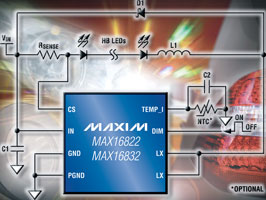

New from Maxim are the MAX16822A/B and MAX16832A/C family of 2 MHz, high-brightness (HB) LED drivers with an integrated MOSFET and high-side current-sense circuitry.
These highly integrated devices reduce the size, complexity, and cost of solid-state lighting (SSL) designs, simplifying the implementation of green lighting technology. Moreover, they provide the high conversion efficiency and advanced thermal management capabilities critical to LED system designs. They are suitable for MR16, MR111, and other architectural lighting applications, as well as front and rear automotive lighting (RCL, DRL and fog/low-beam lights).
These high-voltage, switch-mode HB LED drivers are capable of delivering over 18 W (MAX16822A/B) or 36 W (MAX16832A/C) of output power with up to 95% efficiency, while driving as many as 15 white LEDs in series. The MAX16822A/B can deliver up to 350 mA of continuous DC current, while the MAX16832A/C can deliver up to 700 mA of continuous DC current to the LED string. These devices offer an analog dimming feature that allows the LED current to be controlled by an external DC voltage and PWM dimming input for a wide range of brightness levels.
The drivers require only a few external passive components for the design of a low-cost LED driver circuit. By integrating a 65 V switching MOSFET with RDS(ON) values of 0,85 (MAX16822A/B) and 0,45 (MAX16832A/C), they eliminate the need for an external power transistor. Additionally, high-side current sensing and integrated current-setting circuitry further reduce the number of external components required, while delivering ±3% LED current accuracy.
A hysteretic, step-down mode enables these devices to drive a long string of HB LEDs from input voltages as high as 65 V d.c. This control method renders control-loop compensation unnecessary, thus simplifying the design and minimising component count. The drivers are designed to hold the LED current ripple to within 10% (A versions) and 30% (B and C versions) without the use of an output capacitor. Moreover, they support switching frequencies up to 2 MHz, allowing the use of small-sized components.
The devices integrate thermal-shutdown circuitry to protect the driver under excessive thermal conditions. Their 200 mV, high-side current-sensing minimises the voltage drop across the external sense resistor, thereby reducing power dissipation. Additionally, they provide analog thermal-foldback protection that reduces the LED current in conjunction with an external negative temperature coefficient thermistor when the temperature of the LED string exceeds a specified limit.
The drivers operate from a 6,5 V to 65 V input voltage and are fully specified over the -40°C to +125°C automotive temperature range.
For more information contact Larry Gordon, CST Electronics, +27 (0)11 608 0070, [email protected], www.cstelectronics.co.za
| Tel: | +27 11 608 0070 |
| Email: | [email protected] |
| www: | www.cstelectronics.co.za |
| Articles: | More information and articles about CST Electronics |

© Technews Publishing (Pty) Ltd | All Rights Reserved